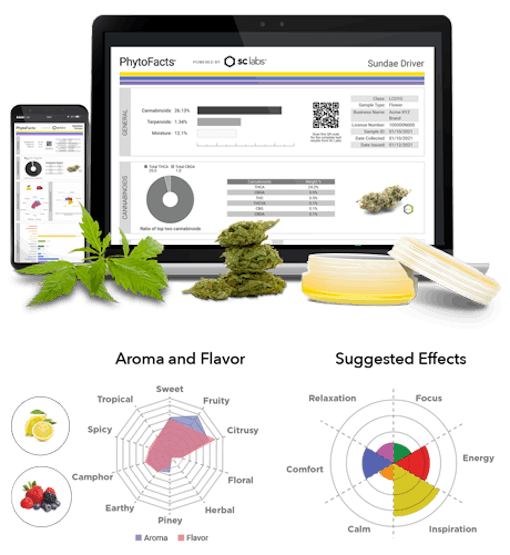How better testing empowers good cannabis
When you look at a cannabis label, you probably notice the THC potency percentage first, and maybe you even choose your purchases based on the most THC for your dollar. But that label can be seriously misleading—in more ways than one.
The rush to get the best THC numbers has led to some shady practices, including “lab shopping,” where cannabis producers seek out labs they know might toss them a few extra percentage points. Because labs don’t want to lose business, it’s not that hard to find one that will play along.
That’s one big reason to stop trusting the label, but it still misses the bigger picture.
“There are a bunch of ways you can look at it,” says Josh Wurzer, a chemist who co-founded cannabis-testing facility SC Labs a decade ago. “You can say that lab shopping is misleading consumers,” he explains. “But I also see it as shortsighted, because THC percentage isn’t necessarily the real quality indicator of good cannabis.”
Enter chemometrics: lab reporting focused on a science-based understanding of the whole plant. Breaking down the facts on other elements like terpenes, according to Wurzer, is going to paint a much clearer picture of the quality and experience you can expect when buying weed than one unreliable number ever could.

Looking beyond THC
You might think that the strain with the highest THC percentage on the label is the best bud. But cannabis strains vary wildly in quality, and THC doesn’t tell the whole story. Thinking in terms of indica versus sativa is an oversimplification, as well.
“I don’t pick my wine based on the alcohol content,” says Wurzer. “And I shouldn’t do that with cannabis either.”
Cannabis scientists like Wurzer look at the role that terpenes play in steering a strain’s effects. These plant compounds not only give your weed a distinct taste and smell, but have an impact all their own.
Earthy and herbal myrcene is the most common terpene found in cannabis, although it’s also present in thyme, hops, and other plants. It is suspected to boost the pain-relieving qualities of a strain. But there’s also pinene, which could help mitigate the memory loss that sometimes comes with THC. Limonene is suspected to promote an uplifting and energetic high, while linalool—also found in lavender—may help quell anxiety.
Each strain has a unique profile of terpenes and cannabinoids playing off each other. The interaction between them and the resulting experience is referred to as the “entourage effect.” It’s why one sativa strain helps you focus, while another has you bouncing off the walls instead—or why one indica strain puts you right to sleep, while another just puts you in the couch.
Besides, a higher THC content doesn’t even mean that you’ll get more THC in your system, even if the label is accurate. According to Wurzer, it just doesn’t matter that much: “If you just hold that hit for a little bit longer, you’re going to get just as much THC into your system from a lower percentage sample.”
Understanding chemometrics
When SC Labs tests a strain, they keep this whole picture in mind—and put it on full display in a data visualization called PhytoFacts®, an exclusive product the lab has licensed.
“It drills down a little bit more and gives people actionable information on predicted effects or flavors that they’re going to get based on that terpene profile, and lists all the terpenes out,” explains Wurzer. “I think it’s on people like us who are passionate about terpenes to really give the consumer some sort of actionable information, and to break it down for them in a way they can digest.”
All the basic info is there, like a detailed cannabinoid breakdown. It takes a deeper dive into terpenes than most, with a detailed picture of the 17 most commonly occurring terpenes. (SC Labs tests for more than 40 different terpenes, but, as Wurzer puts it, “there’s only so much room on the page.”)
Where it gets really interesting is in the data visualization. The algorithm that SC Labs works with breaks all this info down into two charts. One is the predicted aroma and flavor. The other has likely entourage effects, with different levels of relaxation, focus, energy, inspiration, calm, and comfort.

This detailed breakdown can help consumers pick out the best bud, but it can also inform how we interact with our cannabis on a pretty granular level. Terpenes can break down at high temperatures, and some are more volatile than others—so you might end up with a different result depending on how you store it or consume it.
“That’s why vaping a strain can taste very different from smoking that strain,” says Wurzer.
Knowledge is power
SC Labs is charged with testing every single strain entered into the 2021 Emerald Cup, an annual cannabis award event. Wurzer himself is a judge.
“How do you even start with 200 different flower samples from one category sitting on your table?” he says. So, he started breaking down the strains by terpene categories, which helped him out—and he thinks dispensaries should do the same.
“I could walk into a dispensary and get that same breakdown, rather than top shelf, middle shelf, and bottom shelf, or indica or sativa,” he explains. “If I could walk in and say, I want a limonene dominant, let’s see what you’ve got. Where are your myrcene dominants?”
“I think the more the retailers embrace it, the more the consumers are going to catch on,” he adds. “The pot geeks know about it and do already, but to get your casual consumer thinking in that way, the retailers really have to start embracing it and organizing their retail shelves around terpenes.”

SC Labs is a trademark of SC Laboratories, Inc. PhytoFacts is a registered trademark of Napro Research, LLC.






